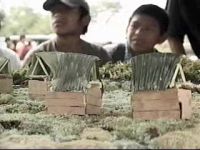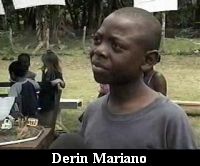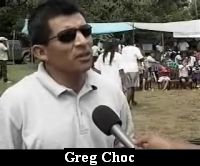
Next to Chiquibul – the Sarstun Temash National Park is Belize’s
second largest forest reserve. It encompasses 42 thousand acres which lie between
the Sarstoon and Temash Rivers and sits squat in the middle of 5 communities
in Toledo. Those are Conejo, Sundaywood, Crico Sarco and Midway – which
are all Mayan and Barranco – a mostly Garifuna village. But its position
in the middle of these communities is what has made management of this wide
swathe of land challenging.
For the last ten years – SATIIM – the Sarstoon Temash Institute
for Indigenous Management has been managing the park. SATIIM has been helping
residents strike that delicate balance with the environment through a sustainable
farming program. A large part of their effort has been in the schools –
and today they got a report card of sorts on the progress of awareness efforts.
Keith Swift travelled to midway village in the deep south.
.
Keith Swift Reporting,
These students live in the five villages that surround the Sarstun Temash National
Park – and as young they may look – they are old enough to know
that their livelihoods depend on the park.
Mateo Canti, St. John’s the Baptist – Conejo
“We will starve or something and the forest provides food for our
health and we actually deal with the forest for food and medicine and all of
those things we need from the forest.”
Rolando Coy, Midway Government School
“We need to keep it because it is important for people in the villages.”
Derin Mariano, St. Joseph R.C. School – Barranco
“We should keep the Sarstun Temash Park healthy because we need it.”
And as much as they need it, recently the park has been under attack because
of unsustainable farming practices.
Mateo Canti,
“Like the Mayas go and just cut down the forest and slash and burn
and those kind of things.”
These students say it all comes down to sustainable farming.
Mateo Canti,
“We need to take care of the forest because people go and just cut
lumber down illegal.”
Desiderius Bol, Teacher – St. John’s – Conejo
“I teach them through like if we do proper management and proper practice
of falling down trees to reduce minimal destruction of these habitats of animals.”
Keith Swift,
What has their enthusiasm been like or their interest?
Desiderius Bol,
“Firstly the interest wasn’t there because they belief was they
should just go there and cut trees to build their homes and I guess to get some
sort of finance. But we are teaching them to do it in a sustainable way. I told
them that doing this practice now is going to ensure that for the future there
will be many more.”
Augustine Lara, Principal – Midway Government School
“They are not saying that they should stop but what we are trying
to use is the wise use, not to over cut, over log, and over hunt. It is just
another way of how we can keep ourselves together but enjoy the resources that
we have at the same time.”
This model shows the situation in Barranco where the beach is eroding. That
yellow structure is the police station on the verge of collapse.
Derin Mariano,
“Like a coconut, we used to have a coconut way on the land but we  had it for like three years and for three years now you can look at the shore
and the coconut tree is way in the sea because of the erosion. If we don’t
do anything about the coastal erosion, it might go too far. Like five years
or so it will go in to more land and the first house that it will take is the
police station because that is the closest one to the sea.”
had it for like three years and for three years now you can look at the shore
and the coconut tree is way in the sea because of the erosion. If we don’t
do anything about the coastal erosion, it might go too far. Like five years
or so it will go in to more land and the first house that it will take is the
police station because that is the closest one to the sea.”
Keith Swift,
So you’re seeing erosion occurring in Barranco?
Derin Mariano,
“Yes sir and the way that we are trying to stop the erosion, to slow
down the erosion is to build rocks at the edge, a lot of big rocks or put some
trees. I think the rocks will help stop the erosions.”
Pollution is stifling Crico Sarco.
Nicholas Pop, Sacred Heart R.C. School - Crico Sarco
“My class has about water and land pollution right in Crico Sarco
right there. We have pollution in our village and maybe it will get worse.”
Keith Swift,
What can be done to fix it?
Nicholas Pop,
“Well it can be, all we do is dig two holes – one is for biodegradable
and non-biodegradable garbage.”
But these students say that in most cases solutions are easier spoken of than
carried out.
Keith Swift,
You go and tell your parents what you’ve learnt?
Rolando Coy, Midway Government School
“Yes, I do tell them.”
Keith Swift,
And what do they tell you?
Rolando Coy,
“Nothing. They don’t respond. They don’t believe what
I say.”
Keith Swift,
You’ve seen them do things that you’ve learnt in school that you
shouldn’t do?
Rolando Coy,
“Yes like cleaning around the river  side. It is not good because it
causes erosion.”
side. It is not good because it
causes erosion.”
Sarah Pau, Midway Government School
“They so slash and burn.”
Keith Swift,
And you tell them that is wrong?
Sarah Pau,
“Yes. They say that they have to do it so that they can plant.”
Greg Choc, Executive Director – SATIIM
“Our approach has been to work with everyone in the village. We’re
working with the school, we’re working with the ladies, we’re working
with the men as well.”
SATIIM’s Executive Director Greg Choc says that survival of these five
communities will depend on these five communities.
Greg Choc,
“We are hoping that the changes that we want to have occur in each
community, change in attitude, will trickle down from the oldest to the youngest
and I think that it would not be the best approach if we only focus on the children.
So we’re working with the parents as well and we’re hoping that
the children’s change in attitude will help to promote a change in the
attitude of the parents as well and vice versa. The changes that are occurring
is being generated by the community and I think that for the challenges that
we’ve confronted collectively together, the solution will have will have
to come from them. The challenge for them though is where do we get the small
support we need to keep those solutions coming into fruition and that is what
we see our role is at this point.”
And with the next generation already waiting – the clock is ticking.
There was a competition among participating schools and Sundaywood
R.C. School won. Midway placed second and the Sacred Heart School in Crico Sarco
placed third. We should note the only villagers that practices traditional farming
within the park are those from Conejo. That is because the Supreme Court has
deemed the land theirs.



